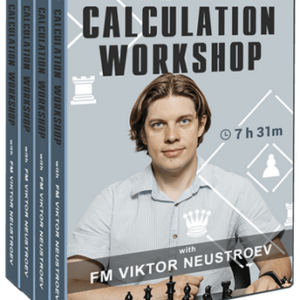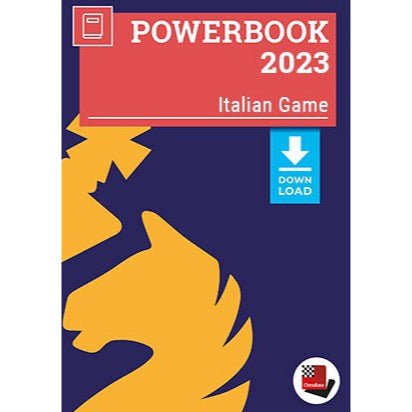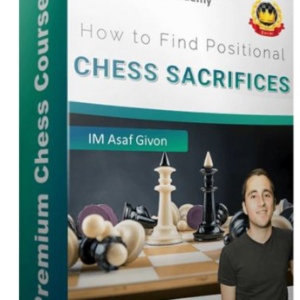Caro-Kann According to Cheparinov – GM Ivan Cheparinov Modern Chess (Release 25 Oct 2024)
Original price was: $ 100.$ 3Current price is: $ 3.
OFF - 97%9999 in stock

Description
Reviews (0)
Description
We are glad to announce another fascinating work by GM Ivan Cheparinov – Caro-Kann According to Cheparinov. In this course, the famous Bulgarian theoretician provides you with a top-level repertoire based on the Caro-Kann Defence.
Nowadays, the Caro-Kann Defence is getting extremely popular at any level. The main reason for this spike in popularity is its strategic complexity. Unlike many other openings, for a lower-rated player isn’t that easy to force a draw against the Caro-Kann Defence. True to his analytical approach, Cheparinov provides many groundbreaking novelties in theoretically important positions. After studying the material, you will be able to play the Caro-Kann Defence at any level.
The course consists of 16 theoretical chapters, 16 interactive test positions, a Memory Booster, and a Video Version (9h and 35min).
Now, we shall take a look at some of the most important theoretical directions. It goes without saying that Cheparinov covers all the sidelines in great depth. In this short overview, however, we will focus on his suggestions against the most challenging lines.
When we tell a high-level player that we are about to publish a new Caro-Kann Defence database, the usual question we would get is, “What is the suggestion against the Advance Variation?”. Therefore, we will start our overview with the move 3.e5 which is White’s most challenging weapon against the Caro-Kann.
The suggestion of Cheparino against this line is 3…c5.

This move has nowadays become very popular. Compared to 3…Bf5, White has less options against 3…c5. Additionally, strong engines proved that White cannot find an advantage after 3…c5.
White has two main continuations against this line – 4.dxc5 and 4.Nf3. Of course, the author examines all the sidelines as well. Against 4.dxc5, Cheparinov suggests 4…e6.

This is the most precise move order for Black. The alternative 4…Nc6?! is dubious in view of 5.f4! e6 6.Be3 when White will next play Bf2 and eventually White’s knight will come to d4.
After 4…e6, White has many options. Three of them, however, are very important – 5.a3, 5.Be3, and 5.Nf3. You should know very well what you are doing against these moves. While it’s not necessary to remember all the lines by heart, pay attention to typical ideas and recurring motifs. By working on the lines, you will develop an intuition for these lines.
The other main move is 4.Nf3. In this case, we continue with 4…cxd4.

Now, White has a choice. He can either recapture with the knight or with the queen. Taking with the knight is more popular. A very topical position is being reached after 5.Nxd4 Nc6 6.Nxc6 bxc6 7.Bd3 e6

Practice, as well as strong engines, proved that this structure is fully playable for Black. Very often the problematic light-squared bishop can be developed by means of …a7-a5 followed by …Ba6.
Against the Classical Variation starting with 3.Nc3, Cheparinov suggests 3…dxe4 4.Nxe4 Nf6 5.Nxf6 exf6

Nowadays, this is Black’s most popular move. The author believes that it offers good chances for Black.
We want to finish our development by playing …Bd6 and …0-0. The queen’s knight will be developed to …Nd7-f8-g6, or …Na6-c7.
Black’s kingside structure is very solid, while it’s difficult for White to push his queenside majority.
Another very popular line against the Caro-Kann Defence is the Two Knights Variation. In this case, Cheparinov provides a simple solution for Black – 1.e4 c6 2.Nf3 d5 3.Nc3 dxe4 4.Nxe4 Nf6 5.Qe2 Nxe4 6.Qxe4 Qd5

This is a relatively rare option. According to the author, Black gets easy equality in this line.
Cheparinov comes up with an interesting solution against the main line of the Exchange Variation. After the moves 1.e4 c6 2.d4 d5 3.exd5 cxd5 4.Bd3 Nc6 5.c3, he suggests the rare but strong 5…e5!?.

A rare move that has gained some popularity lately. It’s a dynamic approach to the position while it also has the approval of the computers. On top of that, there aren’t many games with this move.
Another noteworthy detail is the suggested variation against the main line of the Panov Attack. After 1.e4 c6 2.d4 d5 3.exd5 cxd5 4.c4 Nf6 5.Nc3 Nc6 6.Nf3, Cheparinov suggest 6…a6.

A rare move, which becomes more and more popular. Black makes a useful move and waits for White to show his hand. It’s not worse than 6…Bg4, yet it offers more chances to play for a win. Of course, in the course, you will find all White’s deviations from this position covered as well.
Finally, we will take a very brief look at the suggestion against the Fantasy Variation. After 3.f3, Cheparinov goes for 3…dxe4 4.fxe4 e5 5.Nf3 Bg4!

The most precise move. After …Bg4, Black wants to develop with …Nd7, …Ngf6, …Bd6. In the arising positions, Black can easily play for the full point.
Reviews (0)
Leave a Reply











Reviews
There are no reviews yet.